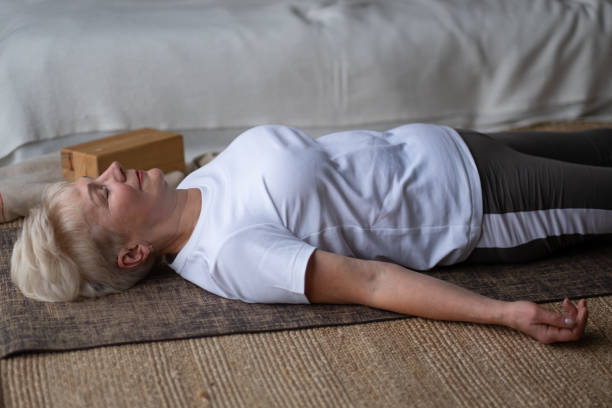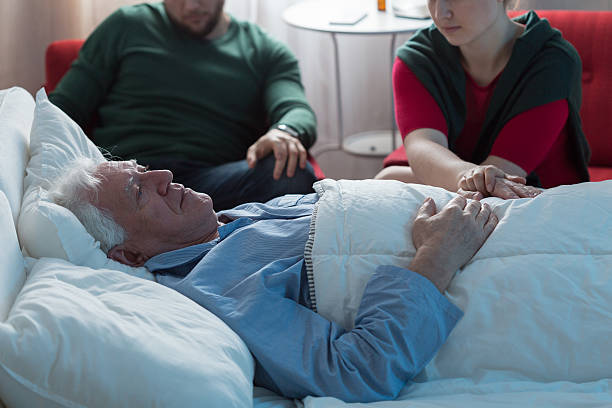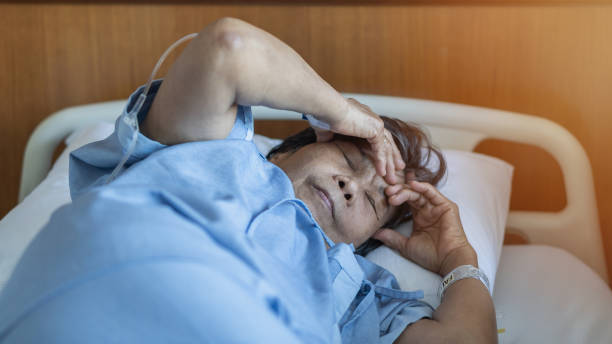Introduction

While managing Parkinson's disease, the significance of sleep and respiratory function may not be immediately apparent. Nonetheless, recent studies have illuminated the vital importance of maintaining proper sleep patterns and healthy breathing in alleviating symptoms and enhancing the overall well-being of individuals living with Parkinson's.
Sleep disturbances, such as insomnia and REM sleep behavior disorder, are common among Parkinson's patients and can significantly impact their quality of life.
Furthermore, breathing difficulties, including respiratory muscle weakness and impaired control, can further exacerbate the challenges those living with this neurodegenerative disorder face. In this blog post, we explore the intriguing link between sleep, breathing, and Parkinson's disease. We delve into how addressing these factors can lead to significant improvements and better management of symptoms for individuals impacted by this condition.
What is the relationship between sleep, breathing, and Parkinson's disease symptoms?

The relationship between sleep, breathing, and Parkinson's disease (PD) symptoms is complex. Studies suggest that abnormal nighttime breathing patterns can be used to identify different PD subtypes.
A new report published in Sleep Medicine Reviews has found a link between Parkinson's disease and a number of sleep-related disorders. These include obstructive sleep apnea (OSA), upper airway resistance syndrome (UARS), periodic limb movement disorder (PLMD), and REM sleep behavior disorder (RBD).
OSA is characterized by episodes of shallow breathing or pauses in breathing during sleep, while UARS is a milder form of OSA that leads to fragmented or interrupted sleep. PLMD refers to the involuntary movement of limbs during sleep, which can result in disrupted sleep. On the other hand, RBD is a condition wherein individuals act out their dreams during REM sleep.
These conditions are associated with PD in different ways. OSA, for example, can worsen motor symptoms such as tremors, bradykinesia (slowing of movements), and rigidity. Also, it has been found that up to 74% of PD patients suffer from OSA and UARS.
People with PD also display decreased rapid eye movement (REM) sleep latency, linked to increased motor symptoms. PLMD may cause excessive daytime sleepiness and fatigue, both common in PD patients. Finally, RBD is strongly associated with prodromal PD, which can be used to identify PD before motor symptoms appear.
By carefully monitoring nighttime breathing patterns, healthcare professionals can better understand the underlying cause of a patient's sleep issues and tailor treatments to their needs. Identifying sleep disorders associated with PD can help diagnose different disease subtypes and pave the way for more effective therapies.
Treating sleep disorders can also help manage motor symptoms and improve quality of life. Therefore, further research is needed to develop strategies for monitoring nighttime breathing patterns to diagnose and treat PD more effectively.
How does Parkinson's disease affect sleep patterns?

Here are 6 reasons why patients with Parkinson's may experience disrupted and altered sleep patterns:
1. Sleep-related breathing disorders such as obstructive sleep apnea (OSA) are more common in those with Parkinson's disease, causing frequent awakenings from sleep.
2. Certain medications used to treat the symptoms of Parkinson's may also lead to insomnia and other changes in sleep patterns.
3. Anxiety, depression, and other common psychological issues among those with Parkinson's can also disrupt sleep.
4. Difficulty falling asleep due to disequilibrium and rigidity of the limbs can be a common problem in those with Parkinson's.
5. Restless leg syndrome (RLS) is more likely to affect people with Parkinson's than the general population.
6. Periodic limb movement disorder (PLMD), characterized by involuntary periodic movements of the limbs while asleep, is also more common among those with Parkinson's.
To better understand and identify subtypes of Parkinson's Disease, researchers have turned to nighttime breathing patterns as a potential marker for disease severity, progression, and subtypes. By examining breathing patterns during sleep, researchers have identified several distinct subtypes of Parkinson's disease that can be distinguished based on their nighttime breathing patterns.
What are the potential mechanisms linking breathing difficulties to Parkinson's disease?
Here are some potential mechanisms linking breathing difficulties to Parkinson's disease:
Altered respiratory drive: The dopamine-containing neurons in the brain lost in Parkinson's disease play an important role in controlling and regulating breathing. Therefore, abnormal dopamine levels may affect the control of breathing.
Postural instability: People with PD often experience postural instability due to impaired balance, leading to difficulty breathing.
Sleep disturbances: PD can also cause sleep disturbances, such as frequent awakenings during the night, which can interfere with normal breathing patterns and decrease oxygen levels in the body.
Motor symptoms: Motor symptoms of PD, such as rigid muscles and tremors, may also lead to difficulty breathing by restricting the movement of the chest wall.
Cardiovascular abnormalities: PD can also lead to abnormal heart rhythms, disturbing a person's breathing patterns.
How Can Night Breathing Patterns Help Identify Parkinson's Disease Subtypes?
Nighttime breathing patterns may provide insight into different subtypes of Parkinson's disease. Studies have demonstrated that people with PD who experience more difficulty breathing during the night may be at higher risk for developing more severe symptoms over time. Additionally, abnormal breathing patterns during sleep are associated with an increased mortality risk in patients with PD.
For these reasons, understanding and monitoring nighttime breathing patterns can help clinicians better diagnose and track the progression of PD. For example, studies have revealed that people with PD who demonstrate abnormal breathing patterns during sleep are more likely to experience cognitive decline, motor fluctuations, and other symptoms over time. As such, monitoring night breathing patterns may be important in evaluating and managing the disease.
Overall, nighttime breathing patterns can provide valuable insight into the different subtypes of Parkinson's disease and help clinicians better diagnose and manage the disease. By monitoring night breathing patterns, clinicians can better understand how PD affects their patients, allowing them to develop more effective treatment plans for managing the disease.
When evaluating and managing Parkinson's disease, understanding nighttime breathing patterns is essential. These patterns offer valuable insights into various subtypes of the disease and are linked to a higher risk of mortality in patients diagnosed with Parkinson's disease (PD).
By monitoring night breathing patterns, clinicians can better understand how PD affects their patients, allowing them to develop more effective treatment plans for managing the disease.
Can specific breathing exercises or techniques benefit individuals with Parkinson's disease?
Yes, there 2 specific breathing exercises and techniques that are beneficial for individuals with Parkinson's disease.
Diaphragmatic Breathing:
Diaphragmatic breathing, also known as abdominal or deep breathing, is a simple technique that helps to relax and reduce stress. The technique focuses on expanding the abdomen instead of the chest when inhaling and exhaling. This type of breathing encourages the full expansion of the lungs, allowing for maximum oxygen intake into the body.
Diaphragmatic breathing can help individuals with Parkinson's disease manage their stress levels, reduce fatigue, and sleep better. Additionally, it helps improve the individual's posture and increase their overall quality of life.
Diaphragmatic breathing encourages the user to focus on the expansion and contraction of the abdomen rather than using their chest muscles when inhaling and exhaling. To do this, the individual must lie down with their back flat on the floor and place one hand on their belly.
When inhaling, they should try to expand their abdomen instead of raising their chest. During exhaling, they must focus on contracting the abdomen and not raising the chest. It is important to keep breathing slowly and evenly throughout the entire exercise.
Pursed lip breathing:
Pursed lip breathing is another beneficial technique for individuals with Parkinson's disease. This type of breathing consists of a slow and steady inhale through the nose, followed by pursing the lips while exhaling. Exhaling should be done twice as long as it takes to inhale. This type of breathing helps to reduce the severity of symptoms associated with Parkinson's disease, such as dyspnea and fatigue.
The pursed lip breathing technique trains the individual to increase their oxygen intake while decreasing carbon dioxide levels in the body. It also helps them stay relaxed and calm while controlling their breathing rate. To perform this exercise, individuals should sit comfortably and close their mouths while inhaling slowly through the nose. When exhaling, they must pursed their lips to prevent air from escaping. Throughout the entire exercise, they must keep their breathing even and steady.
These two breathing exercises can help individuals with Parkinson's disease manage their symptoms more effectively. Moreover, research has demonstrated that specific respiratory patterns can be employed to differentiate various subtypes of Parkinson's disease. By tracking the oscillations in night breathing, doctors can better understand the progression and severity of the condition. Overall, understanding how to properly perform these exercises and properly tracking your night breathing can help individuals with Parkinson's disease improve their quality of life.
FAQ's
Do Parkinson's patients sleep more?
Individuals with Parkinson's disease often experience excessive daytime sleepiness and difficulty falling asleep at night. This can lead to prolonged periods of sleep that can affect their quality of life and day-to-day functioning.
Can breathing exercises help with Parkinson's?
Certain breathing exercises and techniques have been shown to help individuals with Parkinson's disease manage their symptoms and improve their overall quality of life. These include diaphragmatic and pursed lip breathing, which can help reduce fatigue, dyspnea, and stress levels. Additionally, tracking night breathing patterns can help doctors better understand the subtype of Parkinson's disease a patient may have.
How can I reduce Parkinson's symptoms?
To manage Parkinson's symptoms, making lifestyle changes and undergoing therapies can be helpful. Engaging in moderate exercise like walking, swimming and cycling on a regular basis is particularly important. Other helpful treatments include physical therapy, occupational therapy, speech therapy, cognitive behavioral therapy (CBT), medications, and alternative treatments.
Why does Parkinson's make you sleepy?
Parkinson's disease can cause excessive daytime sleepiness due to disruptions in the body's sleep-wake cycle. This is caused by dopamine deficiency, which affects the brain's ability to regulate hormones that control sleep cycles and medications taken for Parkinson's symptoms. Poor sleep quality and lack of restful sleep can also contribute to daytime sleepiness. It is important to speak with a doctor if excessive fatigue or daytime sleepiness persists, as it may indicate an underlying condition.
Do Parkinson's patients talk in their sleep?
Some individuals with Parkinson's disease may experience sleep talking. This is a form of parasomnia or abnormal behavior that occurs during sleep. Sleep talking can range from mumbling words and phrases to more complex conversations and behavior. If you keep having this symptom, it's essential to seek medical advice as it could indicate the presence of another underlying condition such as schizophrenia or dementia.
Conclusion
In conclusion, individuals with Parkinson's can benefit from breathing exercises such as diaphragmatic and pursed lip breathing. These techniques can help reduce fatigue, dyspnea, and stress levels. Furthermore, monitoring nocturnal breathing patterns can assist medical professionals in gaining a deeper comprehension of the disease's advancement and distinguishing between different subtypes. Ultimately, incorporating lifestyle modifications, therapies, and treatments can contribute to symptom reduction and enhance overall quality of life.

